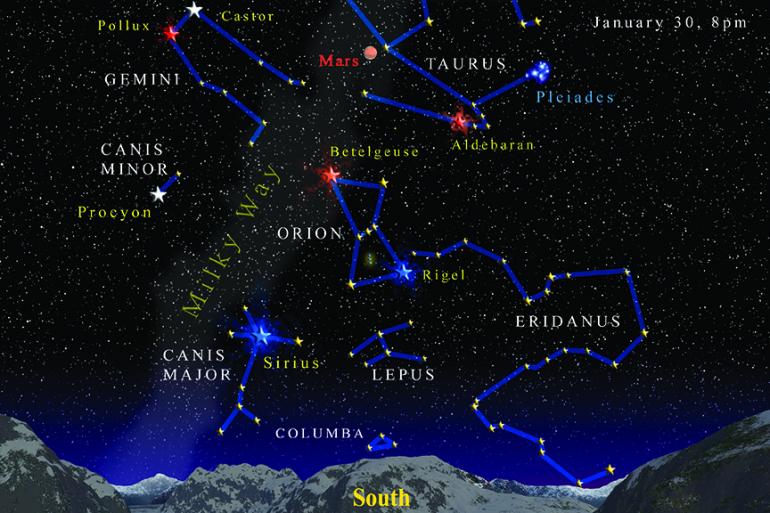Old Man River
Riding high in the heavens.
Ol’ man river,
Dat ol’ man river,
He mus’ know sumpin’
But don’t say nuthin’
Joe, the dock worker in Show Boat, was thinking about the Mighty Mississippi when he sang these words, but the song applies to any of the great rivers of the world—our own Missouri among them. Rivers have always captured the human imagination in terms of both commerce and adventure, and so of course, the sky would have one, too.
The sky river is named Eridanus, a winter constellation that is best found by starting with a pattern you can see more easily: Orion the hunter. Once you locate the famous bright rectangle of the hunter’s body riding high in the south on winter nights, enclosing his belt of three stars, focus on Rigel, the bright first magnitude star in the lower right corner of the rectangle. Just up and to the right of Rigel is a fainter star of third magnitude; this is Cursa, marking the source of the river into which Orion is dipping his toe. Its course runs west and a little south along a string of faint stars, makes a great turn back eastward before it reaches Cetus the whale, then wanders south below the horizon where it finally ends, out of our sight at the latitude of Montana, in the first magnitude star Achernar, not far from the South Celestial Pole.
Hercules found a practical use for it; Eridanus was said to represent one of the rivers the strongman diverted to wash clean the stables of King Augeas—one of his Twelve Labors. It also figures in the last act of the saga of Phaethon, son the sun god Helios, who bit off more than he could chew and ended up in the drink.
Phaethon, like many an adolescent lad itching to get out into the world, couldn’t wait to get the keys to his dad’s chariot: the sun chariot that Helios drove across the sky each day. Phaethon tricked his father into granting him a wish—which was to take the reins—and Helios reluctantly did so.
Things did not go well. The chariot’s steeds immediately felt Phaethon’s lighter-weight and inexperienced hand on the reins. They rushed headlong across the sky and Phaethon was helpless to control them; the chariot careened off course, dipped perilously close to the Earth and the world began to burn. Waters steamed, fields withered, cities flamed, and peoples were scorched. Zeus, king of the gods and not a little alarmed, put an end to the matter with a well-aimed thunderbolt, knocking Phaethon out of the chariot and sending him streaking earthward, his body falling with a splash into the River Eridanus.
Phaethon’s landing spot drew a bit of a crowd. His sisters gathered weeping on the riverbank, turning in their grief into poplar trees, their tears becoming drops of amber in the stream. And Phaethon’s friend Cygnus, diving repeatedly into the waters to try to recover the ill-fated youth’s body, was at last turned into a swan by the gods. (In the early evenings of early winter, you can see the constellation of Cygnus the swan diving earthward on the northwestern horizon—an upright Northern Cross, as it is also called, standing on the horizon.)
Today, the waters of the celestial river are more placid. Its upper western stretch, west of Orion’s foot and just before the great bend, includes an object of interest: the fourth magnitude Epsilon Eridani, an orangish star that at ten or so light years away is one of the nearest to us, and a prime target in searches for radio signals in SETI (Search for ExtraTerrestial Intelligence) programs. None have been detected.
But what we see on frosty winter nights is a meandering river wandering from the toe of Orion in the dark, ever-rolling sky. And as Joe from Show Boat sang: He jes’ keeps rollin’ along!
Jim Manning is a science, education, and public outreach consultant, and the former executive director of the Astronomical Society of the Pacific.












